Research Article: 2018 Vol: 21 Issue: 1S
Entrepreneurship Learning Using Film Media of Culinary Production Process
Ninik Sudarwati, STKIP PGRI JOMBANG
Abstract
The purpose of this research is to evaluate the effectiveness of entrepreneurship learning using film media of culinary production process in improving student creativity on entrepreneurial learning by comparing student creativity before and after intervention in experimental group. The effectiveness was measured using experiment by comparing student creativity before intervention and after intervention in experimental group. The results showed that 80% of the participants in product piloting stated that film about food processing was feasible as a learning media in entrepreneurial learning; it was interesting, creative and contained information of varied culinary product. The results of the effectiveness measurement showed an increase in student’s learning motivation and creativity after learning using film about food processing.
Introduction
Learning entrepreneurship in the classroom requires learning media; audio-visual software is one of the learning media used. The result of development research on film about food processing is one of audio-visual media in entrepreneurial learning containing the process of making cassava cake; it increases the selling value of cassava, which has low value, by turning its form (into cake). The media can assist lecturers in learning and teaching activities in classroom to generate innovative, creative and high-entrepreneurial skill students; this is in accordance with the suggestion given in the research conducted by Maigida & Saba (2013) that entrepreneurial learning in schools encourages the young to be entrepreneurs.
Entrepreneurship is an intellectual capital and useful knowledge as a motor for economic development. All countries are trying to develop entrepreneurship because knowledge management creates added value by converting human capital into organized intellectual assets (Sayadi, Saljughi & Bahraminejad, 2013); knowledge management is primarily based on facts to achieve competitive advantage; intellectual capital is useful for management efficiency, thereby ultimately it will enhance economic growth of a country. In Indonesia, culinary business provides many opportunities for employment in informal private sector because the capital can be adjusted, the products have high inelastic demand and the types of food are varied and innovative. In business world, there is a need for entrepreneurs who have applied skill and ability to manage business. In fact, there is a lack of the number of skilled manpower to manage business, indicating a lack of intellectual capital, so that business products are less innovative and less competitive. Educational activities can foster student creativity; it is a key to improve competitiveness and solve economic problems (Shaheen, 2010).
Entrepreneurial education and training in the form of youth empowerment, effective technical skill and social welfare services is a catalyst for poverty alleviation (Ogundele, Akingbade & Akinlabi, 2012). Entrepreneurial education development is very important to foster student entrepreneurial interest and lead students start their own business after graduate (Manuere, Danha & Majoni, 2013). Entrepreneurial education in universities in Indonesia is not only conducted in department of economics and management, but also in all majors and courses of science and social studies as an elective course for students. The objective of the curriculum of entrepreneurship course is to form students who have high entrepreneurial spirit and are independent in work. Entrepreneurial learning activities are conducted both theoretically and practically. In college, entrepreneurial learning is an activity of teaching and learning process in classroom which requires harmony between the use of media, learning method and evaluation tool. Higher education institutions need to encourage students to improve their skill and focus on innovation (Avvisati, Jacotin & Lancrin, 2013). However, it is also found that entrepreneurial education cannot inspire human resources to be independent, provide real examples and provide other learning sources (teacher-cantered learning). Lecturers have limited access; they used teacher-centred learning, thus they do not give students many opportunities to raise questions and answer questions. This means that lecturer is the centre of learning activities (Zebua, Marsidi, Jama & Yusuf, 2015); it is also explained that this learning method is proven to produce less independent graduates.
Other problems found in entrepreneurial learning in universities are the limited media learning (only in the form of books and PowerPoint slides) and the lack of more real entrepreneurial learning media (3-dimensional media). There is still a need for faster and more accessible ICT-based media to improve entrepreneurial practice skill for students; it requires a real movie about entrepreneurship as instructional media in classroom.
The purpose of this study is to measure the effectiveness of film about food processing as a learning medium in improving student creativity on entrepreneurial learning. Hypothesis: Students in the experimental group have better creativity than before the experiment.
Research Method
Media effectiveness was measured at the limited product piloting; this study was conducted from March until May 2015. The product piloting was limited to students of STKIP PGRI Jombang on economics education program, amounting to 45 students.
The researcher acted as an observer and looked at the difference in entrepreneurial attitude before and after entrepreneurial learning close and directly. The researcher distributed questionnaire consisting of 10 questions to respondents in order to get data of entrepreneurial creativity before and after entrepreneurial learning by using film about food processing as a learning medium. Entrepreneurial creativity was measured using Likert scale; each of which was scored based on 4 (four) criteria as follows: Answer A score=4; Answer B score=3; Answer C score=2; Answer D score=1. The scores above indicates the attitude of respondents towards the questions; score 4 means strongly agree and very good, score 3 means agree, score 2 means disagree and score 1 means strongly disagree, never at all and negative.
Product effectiveness on the trial was measured by using experimental test. The variables of this research were: 1) Variable (X1) is entrepreneurial creativity before entrepreneurial learning using film about food processing; 2) variable (X2) is entrepreneurial creativity after entrepreneurial learning using film about food processing; 3) indicators of entrepreneurial creativity are: The attitude of looking for various products, having active communication with business sector, new innovation, curiosity, being open to changes; 4) data analysis technique used was the test of average difference with T test technique of two interrelated large samples (Montgomery, 2001). The formula is presented below:

Note:
 =Standard error of mean in sample I and sample II.
=Standard error of mean in sample I and sample II.
M1-M2 = Difference between mean before treatment (X1) and after treatment (X1). Data was processed using SPSS version 20.
Students' responses and assessment on film about food processing were explored by analysing the percentage of positive responses; more than 50% of students showed their concern for entrepreneurial behaviour and creativity, followed by intensive interview on the forms of student creativity after using learning media in the form of film.
Steps of Experimental Activity in First Meeting
1. Lecturer provided apperception about the impact of low entrepreneurial creativity in business world.
2. Lecturer conducted pre-test by distributing questionnaire about creativity in business world and interviewing students about their general condition of creativity.
3. Lecturer explained the definition of creativity, the benefits, the business and the profits in culinary business.
4. Lecturer provided question and answer section for students about the benefits of creativity in culinary production.
5. Lecturer played film about food processing and suggested students to take notes about the creativity presented in the film.
6. Lecturer gave students an opportunity to discuss the lack of creativity in the film and to provide suggestions to overcome it.
7. Lecturer gave written questions with free answers on knowledge about various culinary products, ideas to modify the existing product, number of contacts in creativity exploration, ideas on new products, simple business plans and technology use.
Steps of Experimental Activity in Second Meeting
1. Lecturer formed groups based on the type of product plan.
2. Lecturer gave each group an opportunity to express their thoughts or ideas, while other groups provided suggestions and inputs towards the ideas; the answers of all students were collected.
3. Lecturer drew a conclusion of students’ answers and conveyed the results to the students.
Research Results
Need Analysis
1. 70% of the students are senior high school graduates with no practical skill which can be used as a basic capital of entrepreneurship; and 60% of the students were less innovative.
2. 70% of lecturers stated that the time for entrepreneurial learning in delivering theories and practicing activities was very limited.
3. 70% of the students expected ICT media which are simple, complete and in line with the real life.
4. 70% of the lecturers expected film about food processing which is brief, solid and simple and in line with reality as a learning medium in class in order to improve student skill and foster student innovation. In general, lecturers and students need entrepreneurial learning media in the classroom which is in line with reality and in the form of skill in making products.
Media Design in Terms of Scenario Design and Film Material
The film design includes opening/introduction (the presenter conveys the activities to be presented and the benefits of the film for learning activities). Movie material was the procedure of cooking cake made of cassava and sweet potato to increase their selling value, including: Bobi cake (sweet potato ball with chocolate), rainbow cassava satay, cassava cake, wingko cake (made of cassava), yellow rice with lemongrass and yellow rice with fragrant corn.
Media Development and Implementation
Development of media in the form of film containing: 1) Movie title (Figure 1); 2) Author (Figure 2); 3) Opening: The presenter explains about how to make various types of cake made of cassava (Figure 3); 4) The presenter explains the cooking process with the chef making each cake (Figure 4). The film has been published on YouTube entitled "The Way to Cook Traditional Cake in Indonesia” by Dr. Ninik Sudarwati".
Your figures should always be centered and should have a title for reference purposes. When you create figures, remember to use Times New Roman as the font in the figure and think about how it will look in the journal. Generally, figures should not exceed 6 inches in width. Keep in mind that the hard copy journals are printed in black and white, which might alter how you format your figures. The PDF versions will be in color. Put the figures where you want them to appear and format them the way you want them to look in the final document.
This was conducted on limited product piloting on 45 students by using film about food processing as a medium in entrepreneurial learning in classroom. The researcher served as a model lecturer teaching entrepreneurial practice by using film about food processing as a learning medium. The followings are comments and suggestions about film about food processing: “The name of the cake is quite interesting and unique so as to attract the viewers’ attention”, “the details of raw material are quite clear”, “the explanation of the cooking process is quite clear”, “the raw material is affordable”, “the number of cake menu is still lacking; more films about food processing are required, especially staple and vegetable dishes. Speaking of the benefits of learning using film as the learning medium, 90% of students said that the film is very useful as additional information for them to create something new, to innovate new products with affordable materials and to increase the selling value of the product. In general, film about food processing has been feasible and can be used as a medium in entrepreneurial learning.
The analysis results of the limited product piloting using t test statistic (table) two-paired samples were processed with SPSS 20 windows with paired sample T-test method: Paired sample test results included difference between average score in pre-test and post-test amounted to -7.3333 (31.311-38.6444). The standard deviation of 2.02260 and t count value of -24.322, probability or Sig value (2-tailed) of 0.000<0.05. It can be concluded that alternative H was accepted, with the statement: Students in the experimental group have better creativity than before the experiment. Therefore, the media in the form of film about food processing was effective to be used as a learning medium in entrepreneurial learning in classroom.
Discussion
Based on interview with students, entrepreneurial learning media in the form of film about food processing is expected to have a clearer audio-visual form; provide information about real-life skill; and presents information which is much needed generally, simply, creatively and innovatively. Audio-visual media used in learning and teaching activity was in line with the results of the study conducted by Ashaver & Igyuve (2013) that the use of adequate audio-visual material is required by lecturers and students in learning and teaching activities; it needs to be provided at college in terms of quantity and quality of media. Audio-visual media is very useful for lecturers and students in learning and teaching activities. In general, learning media in the form of film about food processing is a visual media that is practical, real, simple and in accordance with the demands of learning technology; cooking cake is a culinary activity, which is a need for lecturers and students in more real entrepreneurial learning in classroom and highly needed by consumers.
The result of t-test statistic test at a significant level of 0.05 indicated that there was difference of average score before and after entrepreneurial learning by using film about food processing as learning medium; it also shows an increase of average score after implementation of learning using film about food processing. This is in accordance with research conducted by Ode (2014) that the use of audio-visual resources had a significant impact on teaching and learning activity in secondary school. Ode also explained that from 120 respondents, all of them agreed that audio-visual resources stimulated learning and teaching activity and provided logical experience; 70% of respondents said that audio-visual media solved educational problems as a real source of information.
In general, film about food processing is an audio visual media as medium in entrepreneurial learning; this is one of the uses of ICT in education.
Conclusion and Suggestion
Film about food processing, as one of audio-visual media to help lecturers in learning entrepreneurial skill, has been applied in college. It is also found that the learning medium is useful to grow student creativity and make students innovate new products with entrepreneurial learning that is more fun and not boring. Further researcher is suggested to conduct other ICT development research complementing each other, e.g. film about craft production process, film about cooking of staple food, film about brief entrepreneurial theory and others; this is aimed to create varied audio-visual media to grow student creativity, which leads to new innovation of products.
References
- Ashaver, D. &amli; Igyuve, S.M. (2013). The use of audio-visual materials in the teaching and learning lirocesses in colleges of education in Benue State-Nigeria. IOSR Journal of Research &amli; Method in Education, 1(6), 44-55.
- Avvisati, F., Jacotin, G. &amli; Lancrin, S.V. (2013). Educating higher education students for innovative economics: What international data tell us. Tuning Journal for Higher Education, 1(1), 223-240.
- Borg, R.W. &amli; Gall, M.D. (1989). Educational research: An introduction (fifth edition). England: Longman liublishing.
- Buchholz, R.A. &amli; Rosenthal, S.B. (2005). The sliirit of entrelireneurshili and the qualities of moral decision making: Toward a unifying framework. Journal of Business Ethics, 60, 307-315.
- Maigida, J.F. &amli; Saba, T.M. (2013). Entrelireneurial skills in technical vocational education and training as a strategic aliliroach for achieving youth emliowerment in Nigeria. International Journal of Humanities and Social Science, 3(5), 303-310.
- Manuere, F., Danha, K. &amli; Majoni, T. (2013). Entrelireneurshili attitudes and knowledge: A survey of fourth year university students. Interdiscililinary Journal of Contemliorary Research in Business, 4(9), 511-521.
- Meenakshi. (2013). Imliortance of ICT in education. IOSR Journal of Research &amli; Method in Education, 1(4), 3-8.
- Montgomery, D.C. (2001). Design and analysis of exlieriments (fifth edition). New York, NY: Jhon Wiley &amli; Sons, Inc.
- Ode, R.O. (2014). Imliact of audio-visual (AVs) resources on teaching and learning in some selected lirivate secondary schools in Makurdi. IMliACT: International Journal of Research in Humanities, Arts and Literature, 2(5), 195-202.
- Ogundele, O.J.K., Akingbade, W.A. &amli; Akinlabi, H.B. (2012). Entrelireneurshili training and education as strategic tools for lioverty alleviation in Nigeria. American International Journal of Contemliorary Research, 2(1), 148-156.
- Sayadi, S., Saljughi, Z.S. &amli; Bahraminejad, Z. (2013). Intellectual caliital and organizational entrelireneurshili. Interdiscililinary Journal of Contemliorary Research in Business, 5(3), 612-626.
- Shaheen, R. (2010). Creativity and education. Creative Education, 1(3), 166-169.
- Zebua, E., Marsidi, S., Jama, J. &amli; Yusuf, A.M. (2015). Develoliing the active learning model to imlirove the effectiveness study grouli on entrelireneurshili in higher education (A case at the Art Institute of Indonesia liadang lianjang). IOSR Journal of Humanities and Social Science, 20(1), 24-28.



